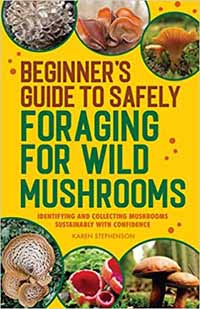

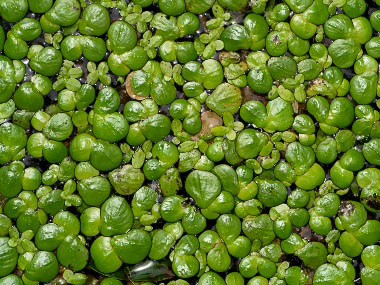


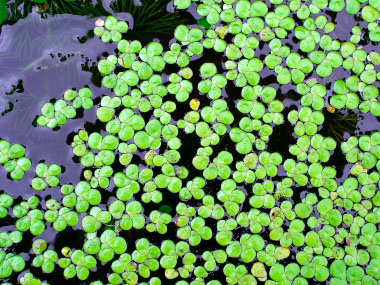
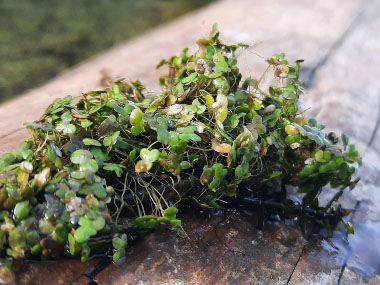
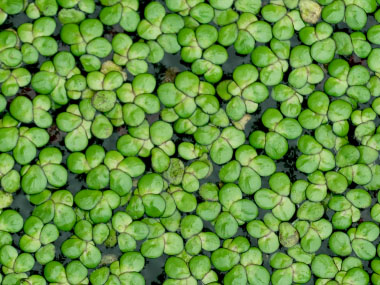
To support our efforts please browse our store (books with health benefits, etc.).
The duckweeds (genus Lemna) are in the duckweed family (Lemnaceae). Among the smallest of all flowering plants, common duckweed is a free-floating aquatic perennial that forms a floating mat (colony) of minute foliage. This plant can be used to remove excess nutrients or toxic metals from water bodies because it is an efficient bio-accumulator. Due to this fact, it is very important to make sure that the body of water in which they grow is not polluted or contaminated if you intend on foraging. Nine duckweed species occur in North America. Common duckweed (L. minor) is the most widespread species, ranging across Canada and reported for all states except Hawaii and South Carolina. Identifying specific duckweed species can be tricky due to their minute size and absence of showy floral characters. The dried plant is known to repel mosquitoes. The whole plant is alterative, antipruritic, antiscorbutic, astringent, depurative, diuretic, and febrifuge. This aquatic plant is used in homeopathy for a number of ailments including the treatment of colds.
Distinguishing Features
Easy to spot as they form a foliage mat consisting of very tiny leaves (fronds).
Flowers
Duckweed plants rarely flower. Flowers are contained in pouches near the base of the plant with a narrow opening at the top. There is usually 1 flower per plant, rarely 2. Flowers lack petals or sepals; they have two stamens and a single style.
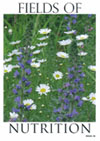 Fields
of Nutrition has medicinal benefits and vitamin/mineral content of Common Duckweed.
Fields
of Nutrition has medicinal benefits and vitamin/mineral content of Common Duckweed.
Leaves
Leaves are referred to as fronds, and they float on the water's surface. The fronds (leaves) are very small measuring 1 to 8 mm (less than 1/3") long. They are one to two times as long as wide, oval to egg-shaped, widest at or above the middle. They are rounded at the tip, lack a stem, and are faintly 3-veined. The upper surface is bright green and relatively flat. Sometimes 1 or more minute bumps are present along the midvein but these are mostly obscure. The lower surface is typically green, seldom slightly tinged red or purple.
Height
No height, they grow flat on the water's surface.
Habitat
Common Duckweed is found in slow moving waters of lakes, ponds, marshes, swamps, and slow-moving streams. Native to North America, this aquatic plant can be found in many locations throughout Canada and the U.S.
Edible Parts
Duckweed has a high protein content, which makes it valuable as human food. If duckweed grows under optimal conditions, it can contain up to 40% of protein. This protein is relatively easily absorbed in the body. However, it also contains calcium oxalate so eating in moderation is critical. Duckweed contains vitamins A, B complex, and B12. It also contains antioxidants like flavonoids and carotenoids. Other nutrients include essential and conditional amino acids, polyphenols, dietary fiber, iron, and zinc. It is VERY important to harvest duckweed from clean water sources only!
Other Name
Lesser Duckweed.
Similar Plants
Turion Duckweed, Lemna turionifera.
Winter Survival Food Handbook

PDF Plant Magazines
Types of Wild Food
Geographic Zones Seasons
Disclaimer
EdibleWildFood.com is informational in nature. While we strive to be 100% accurate, it is solely up to the reader to ensure proper plant identification. Some wild plants are poisonous or can have serious adverse health effects.
We are not health professionals, medical doctors, nor are we nutritionists. It is up to the reader to verify nutritional information and health benefits with qualified professionals for all edible plants listed in this web site. Please click here for more information.
Why Edible Wild Food?
- Food costs are rising
- Free, wild food is readily abundant
- Wild food adds nutrition to your diet
- Wild food can help treat various medical conditions





